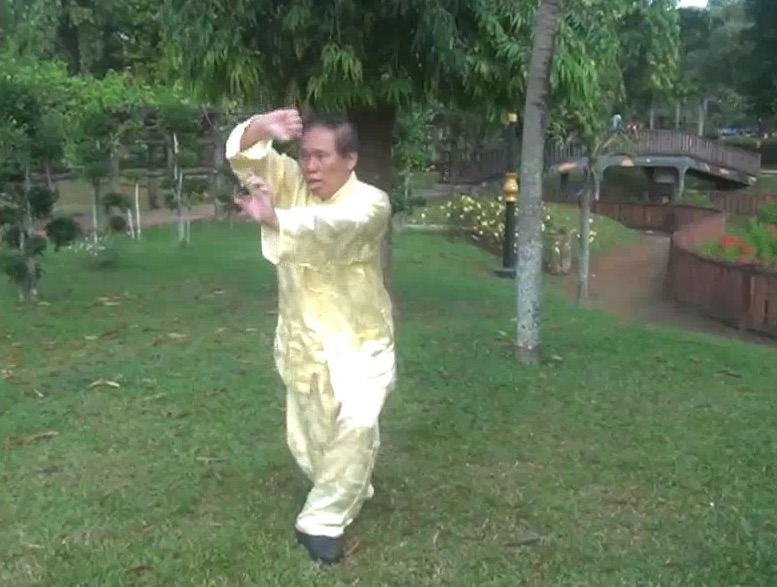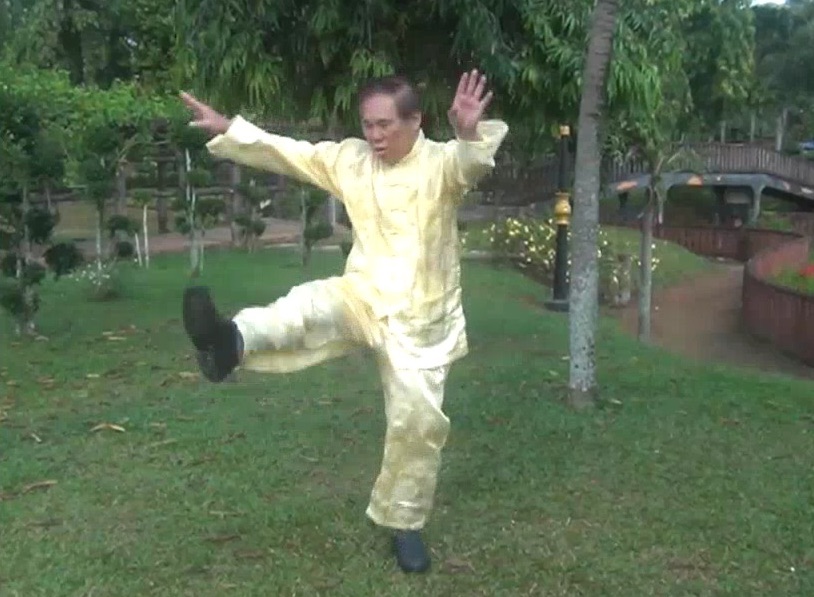THE SPECIALTIES OF WONG FEI HOONG

"Sun-Moon Shadow Hand" looks innocent but it incorporates the deadly no-shadow kick
Question 11
What is the essence of Wong Fei Hung? And particularly what is the essence of each of the sets, i.e. Iron Wire, Taming Tiger, Tiger Crane and Fifth Brother Octagonal Staff?
Sifu Anton Schmick
Answer
The essence of Wong Fei Hoong is Tiger-Crane, which is manifested in his tiger-claw and no-shadow kick.
Wong Fei Hoong’s tiger-Claw is very powerful. There were no records of how he trained the force for the successful application of his tiger-claw. But the orthodox methods, employed by most tiger-claw masters, were jabbing fingers into beans and gripping beans.
These are external methods, but trained correctly they develop internal force, which is usually hard. It is a common misconception that external methods only develop external force, and internal force must be cultivated internally and is always soft. “External”, “internal”, “hard” and “soft” are various ways to describe methods of training both internal force and external force. Internal force can be externally trained and hard, though it is usually internally trained and soft, thus the misconception.
Tiger-claw is combat ending by itself, i.e. even if you let go of the grip after applying the tiger-claw technique, your opponent cannot fight you any more. There are three main ways of tiger-claw application, namely:
- fen khen, or separating tendons.
- Chor chit, or dislocating joints.
- Na yuie, or gripping energy points.
Wong Fei Hoong’s more formidable technique is the no-shadow kick. But he did not use it often because his tiger-claw, or even his ordinary techniques were sufficient to defeat his opponents.
The kick is called no-shadow becaue it is so fast that an opponent cannot even sense its shadow. But the forte of the kick is actually not its speed, but the tactics of applying it. In theory any kick can be a no-shadow kick if it is executed with the no-shadow tactics, but the following techniques are the most common:
- Organ-seeking kick.
- Tiger-tail kick.
- Clutch kick.
The following patterns are frequently used to executed the above techniques:
- Single Leg Hungry Crane.
- Single Leg Flying Crane.
- Sun Moon Shadow Hand.
- Lazy Tiger Stretches Waist.
- Fierce Tiger Springs Claws.
- Immortal Li Steps on Clutch.
- Immortal Li Kicks Clutch.
Wong Fei Hoong transmitted his no-shadow kick to his favorite disciple, Leong Foon, and his tiger-claw to his most famous disciple who later spread his lineage wide and far, Lam Sai Weng.
Tiger-claw and no-shadow kick happen to be my specialties too. I shall teach them at the UK Summer Camp 2014.
The essence of the Iron Wire Set is to develop internal force. It is probably the most powerful kungfu set for this purpose. However, today it is frequently practiced wrongly as isometric exercise, which produces big muscles instead. Having big muscles will produce a lot of strength too, but its benefits are different from those of internal force.
A tell-tale sign of practicing Iron Wire as isometric exercise is having big muscles. The eyes of the practitioner are often dull, and he becomes tired easy. He is also prone to anger.
One who trains Iron Wire as an internal art is powerful, but slender and elegant. His eyes shine and he is peaceful, happy and full of vitality.
The Iron Wire Set was composed by Thiet Kiew Sam, the most senior of the Ten Tigers of Canton. He based his composition on the Triple-Stretch Set, which he learned from his sifu, the Venerable Cheng Choe, who in turn learned it from the Venerable Sam Tuck, the second most senior disciple of the Venerable Chee Seen, the First Patriarch of Southern Shaolin Kungfu.
The main technique in building internal force in Iron Wire is consolidating force. This delicate skill is frequently confused with tensing muscles, which leads to the deviation of practicing Iron Wire as an isometric exercise. A tell-tale difference is that when you consolidate force, you feel fresh and relaxed. When you tense your muscles you feel locked-up and tired.
The essence of the Taming-Tiger Set is combat application using tiger techniques, especially the tiger-claw. There are many effective combat sequences incorporated into the set, though many practitioners may not realize them. As the standard of sparring today is not high, if you practice these combat sequences well and just apply them on your opponents, you have a very good chance of beating then.
The structure of this set, like that in many Southern Shaolin sets, is to train internal force at the beginning, then practice combat sequences for fighting. The force training method is the triple-stretch. In Wong Fei Hoong’s lineage, the force training is performed while standing upright, but in our school it is performed on a Horse-Riding Stance.
As its name indicates, the essence of the Tiger-Crane Set is the tiger and the crane. However, in the 108-pattern Tiger-Crane Set in Wong Fei Foong’s lineage, the set is based on Lohan Kungfu. Hence, Lohan patterns constitute a huge part of the set. In the 36-pattern Tiger-Crane Set I learned from Uncle Righteousness, and the 72-pattern Tiger-Crane Set I learned from Sifu Choe Hoong Choy, most of the patterns are tiger and crane techniques, with prominence of tiger techniques in Uncle Righteousness’ set, and prominence of the crane techniques in Sifu Choe Hoong Choy’s set.
Tiger techniques are ferocious. The essence of the tiger is the tiger-claw. Crane techniques are elegant. The essence of the crane is the organ-seeking kick, which forms a part of no-shadow kick.
Fifth Brother Octagonal Staff, or Ng Long Pat Kua Khun in Chinese (Cantonese), is one of the four famous staff sets in kungfu, the other three being Six-and-Half-Point Staff, Flowing Water Staff and Fishing Staff. All these staff sets are from Southern Shaolin.
The Fifth Brother Octagonal Staff is a right-hand staff, i.e.the right hand, which is the controlling hand, is in front, though there are a few patterns where the left hand is in front. All the other three Staffs are left-hand staffs, i.e. the right hand, which is also the controlling hand, is at the back.
Interestingly, the essence of all these famous staffs is the thrust, which is typical of a spear, and not the hit, which is typical of a staff. If you look at other staff sets, you may find a lot of hitting.
Of the four staff sets, Fifth Brother Octagonal Staff when compared with the other three, is relatively the one with the most hitting techniques, though the number of hitting techniques is actually small. This is probably the reason why it is a right-hand staff.
The Fifth Brother Octagonal Staff was invented by Yang Wu Lang, a famous Song dynasty general who was the fifth in his family, and famous for his spear. After being ambushed by the Tartars, he escaped to a Buddhist temple on Wutai Mountain and became a monk. He continued to practice his spear everyday, but in line with Buddhist compassion, he took off the spear-head. His practice is passed down to posterity as the Fifth Brother Octagonal Staff.

Interestingly, Grandmaster Wong learned the formidable application of this deadly no-shadow kick from 72-Pattern Tiger-Crane Set of Choe Family Wing Choon
The questions and answers are reproduced from the thread Legacy of Wong Fei Hung Q-A Series by Sifu in the Shaolin Wahnam Discussion Forum.
LINKS
